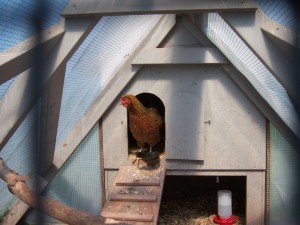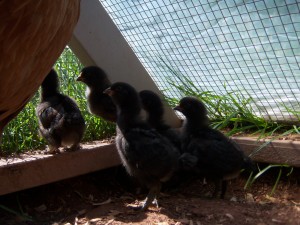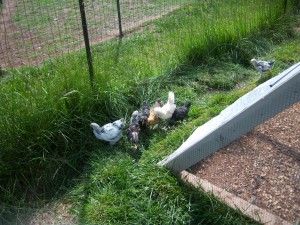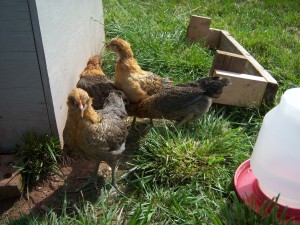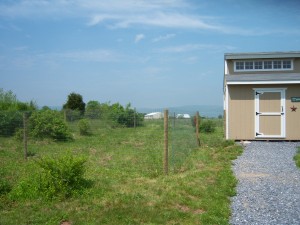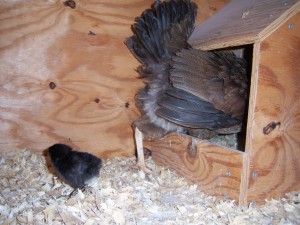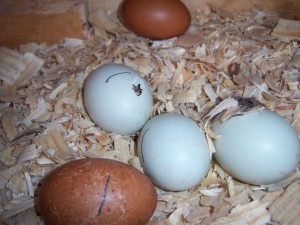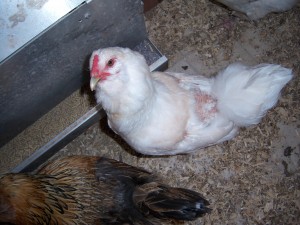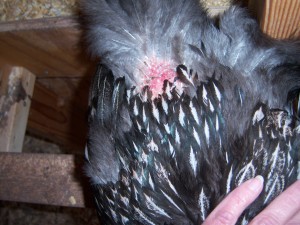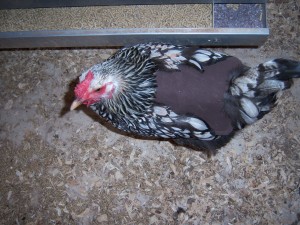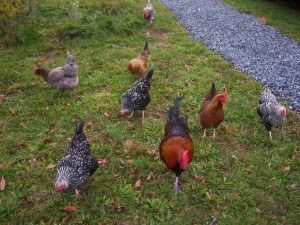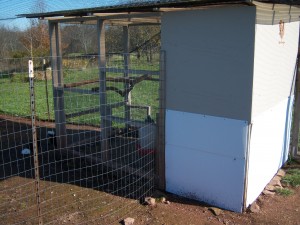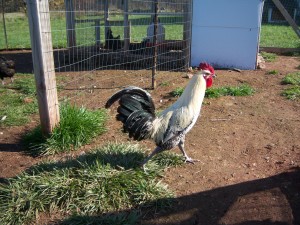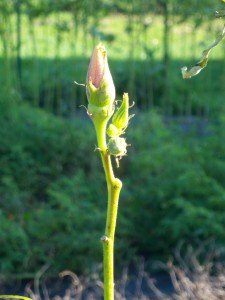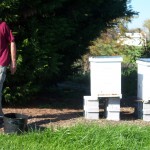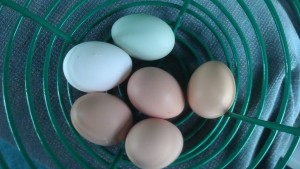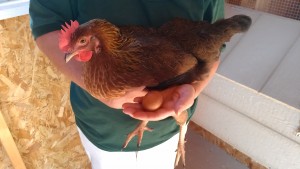Chickens

Chick update
0Daisy’s six chicks are doing very well. Daisy is doing a wonderful job of teaching them the life skills for being a successful chicken – scratching, pecking, and running away from any other creature, which is mainly us. Scooter and Erinn recently got one lonely chick from a broody hen, so we loaned out two of Daisy’s babies as companion chicks. The lone chick wasn’t doing so well on her own learning her life skill. I drew up the loaner chick rental agreement, but never got it signed. I’ll probably never see that six-pack of good beer. Two of the babies have developed some brown on their wings and they are the two with some feathers on their feet, so it seems like these two must be from the Maran eggs, but could be pure or could be half R.I. Red.
It is always fun to watch them grow up and see how the Cockerels develop, but then in the back of our minds we know their eventual fate and that is a little bit sad to think about.
The 14 six-week old chicks finally went outside for the first time over the weekend. It was a little traumatic at first – so much space and so much sun – but they eventually seemed to enjoy exploring. The grass was a little tall for them, but hopping and flapping got them around the nursery coop yard nicely. Daisy and her peeps were inside the nursery coop and the older one were outside the coop. This should give them a chance to get to know each other. A brief encounter between Daisy and the older birds, let us know that they aren’t ready to be put together yet.

Second chicken yard
0We finally finished the second chicken yard a few days ago. The one-year-old chickens have completely eaten down the original yard and by moving the birds now I think the grass will come back. It’s trying, but with the chickens there it doesn’t stand a chance.
The new yard is about the same area or perhaps slightly larger. It is the area where I drove the little earth mover that I rented to excavate for the coop foundation so it is full of ruts. I tried to even out the ground a bit, but it is still quite lumpy. The chickens take advantage of exposed or loose dirt and ruts to scratch around in and take dirt baths, but sure makes it tough to cut the tall grass. The birds seem to largely ignore tall grass, so I want to cut it down to make it more appealing and give them some greens to eat. As it is they really just look for the dirt patches and scratch for bugs. I am hoping that the two yards will be sustainable – that is until we introduce more chickens. I can let them out of the yards to graze on the rest of the property, but we are refraining from doing that until the garden get more established. We don’t want them scratching up our tender little plants.

Daisy’s chicks
0Daisy, a Welsummer hen hatched her chicks yesterday and this morning. She was setting on seven eggs. Yesterday the first one hatched out, the second one didn’t make it and died and the five remaining went into the night. I don’t know if chicks hatch out at night or somehow know when it is morning and wait, but by 9 am this morning I counted five. I might have missed the sixth one or it might not be hatched yet. We’ll know later today. She was setting on two Maran or Welsummer eggs and five Ameraucana eggs. There are only two roosters – a Maran and a Rhode Island Red – but the Red is dominant and seems to do most of the fertilizing. So they are likely Red crosses with a slight possibility of a pure Maran. All the chicks are black with the exception of the one that died.
When Tilda hatched her eggs two years ago, they were mostly black as well. I wonder if that is common for crosses. They might not stay black, but we’ll have to wait to see how they turn out when their feathers come in. Tilda’s crosses were nice big birds and the hens have been good layers.
We plan to breed the Maran with the three Maran hens this year, but I need to build another nursery coop before that can happen. I better get moving.

Relief for the hens!
0Our flock of 1 year old birds is doing very well. This is the group that lives in the “Palace” – the nice new coop that consumed our entire spring last year as we were building it. There are 12 hens, 2 roosters and 6 guineas in this flock. They are more like 2 separate flocks though. The chickens and guineas basically just ignore each other. We don’t really ever see them interacting at all and they roost in separate areas. Once the days started increasing in length the hens started laying more and we are getting a good number of eggs from both flocks. With 2 big roosters in the Palace flock, some of the girls were really starting to get scratched up from the treading of the active roosters on their backs. It was obvious which hens were favorites and I felt so sorry for them with their sore-looking bare backs. After a bit of research online, I found this is a very common problem and there are a lot of protective products available to help give hens some relief.
I found Hen Saver Chicken Saddles and ordered 2 to see how they would work out. They are very simply constructed pieces of heavy duty material shaped to fit the hen’s back and are held in place by elastic that slips over the wings. The elastic is nice and loose when in place and doesn’t seem to bind or pinch at all. The first 2 hens to try on their saddles didn’t seem to mind at all and went right about their business of scratching around the yard. I gave the saddles a few days to see if they really would stay in place and help to protect the hens. Well they passed the test and have stayed in place beautifully so I ordered 4 more. The saddles are such simple little things but they really seem to be working well. Here is a picture of Wanda modeling her new saddle. Eleanor has a pretty navy one that I will have to get a picture of.

Mild Winter
0We are having the mildest winter that I can remember. The only real snow was in October and most of February felt like April. Yesterday was 70 degrees.
Chickens
The spring projects are starting to pile up. We need to fence off another yard for the chickens. The new birds have eaten all the grass down to the nubs, but I think it will come back if we can put the chickens in the new area soon. I will have to put in six or 8 posts and another 150 to 200 feet of fencing. This new yard is where the tractor was working during the excavation for the chicken palace, and there are big ruts everywhere. I want to try to fill in most of those ruts and then mow the tall winter grass down. That is a couple of weekends, right there.
Google photo album: Chickens 2012
The next project is to build a new nursery coop so we can put a setting hen in a quiet place to raise some babies. We will need to get rid of Tarick the feisty rooster who terrorizes Percy, but seems to lack the instinct to protect his hens. When Tarick is gone we can split up Duran and Big Red and give those hens a break. With the two roosters together the hens are getting pretty beat up.
One of the hens has developed a taste for eggs. Not good. I think it is either Pearl or Bonnie or Violet. All three are Marans. They lay the chocolate brown eggs and I would hate to have to get rid of one of them, but we don’t want to let this behavior continue. We want to raise Marans chicks, however, so we will hopefully have a new supply of Maran egg layers by fall. I wonder if that trait of eating eggs is hereditary.
We have seven new peeps arriving around April 8. We are getting three new Ameraucanas, two Brahmas, and two Barred Rocks.
Still no eggs from the guineas, so they must all be males. They are now able to fly over the fence and they wander around, but never go too far away and always want to go back into the coop at night to roost. They are great ‘watch birds’ – squawking at anything new or different – but they are not producing anything of value, except perhaps some fertilizer.
Honeybees
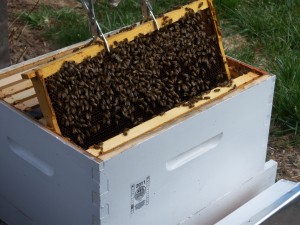 Yesterday I did a big spring inspection. For the first time since adding the second brood boxes to my two hives last summer, I inspected both the upper and the lower boxes. Boston, always the busier hive, had more bees, still lots of honey, some new brood and a little space to expand on the outer frames. I switched the boxes, putting the lower box on top. It was definitely lighter and had more space. I took some pictures as I went and the whole process took about 45 minutes. Because it was 70 degrees, I don’t think the bees minded too much. I never saw either queen, but there was new brood, so she is laying. As careful as I could be, there are still casualties replacing frames and moving boxes around like I did, and I can only hope that the queen is OK. There is always that risk. I didn’t swap the boxes on Anaheim hive, as there was more room in the top box, but I think I will swap them in a few weeks.
Yesterday I did a big spring inspection. For the first time since adding the second brood boxes to my two hives last summer, I inspected both the upper and the lower boxes. Boston, always the busier hive, had more bees, still lots of honey, some new brood and a little space to expand on the outer frames. I switched the boxes, putting the lower box on top. It was definitely lighter and had more space. I took some pictures as I went and the whole process took about 45 minutes. Because it was 70 degrees, I don’t think the bees minded too much. I never saw either queen, but there was new brood, so she is laying. As careful as I could be, there are still casualties replacing frames and moving boxes around like I did, and I can only hope that the queen is OK. There is always that risk. I didn’t swap the boxes on Anaheim hive, as there was more room in the top box, but I think I will swap them in a few weeks.
Google photo album: Honeybees 2012 Mar
Because of the warm winter, the new packages coming from Georgia will be arriving this weekend which is a couple of weeks earlier than usual. I still need to put some deep frames together, but otherwise I am ready for them. Because of the early start, I will need to feed them a lot until the nectar flow starts. I am really hoping for a strong flow and good weather during the Black Locust bloom. Losses of hives is typically in the 30% to 40% range, but it looks like my two made it. It’s a little too early to be sure, but unless we get an extended cold snap, I feel pretty good about my hives making it.

Preparing chickens for winter
0We are having a nice little warm spell this past week and it should continue for several more days. This is great for preparing for winter. I can’t forget that a couple of weeks ago we had a small blizzard. Winter is on the way, no doubt about that. So while the weather is in the 60s and sunny, I should be winterizing the garden, the bees and the chickens.
I found a great article about ‘winterizing’ the chickens in a blog at The Guardian, so rather than reword and retype, I will just reference. The article is full of great information, which will spur me to action right after lunch and a nap.
The article talks about sub-zero temperature which we rarely have, so our chickens will be fine, but we do need to put up a little more plastic wrap around the coop screens just to keep the wind, rain, and snow at bay. Ventilation has never been a problem and the new chicken palace was designed with plenty of air flow. We may still want to move the chickens around between the three coops, but with four roosters creating new groups is tricky.
Our two-and-a-half-year-olds are all still in the middle of a big molt and I am hoping that they develop their new feathers soon. They look awful, but more importantly, they are very vulnerable to the cold in this condition. Percy is one of them, and along with the loss of feathers, he has clearly lost his mojo. He was the alpha bird until the molt and how he will run and hide if put in the same space as the new, much smaller, Tarick. We really should just get rid of Tarick. We are not planning to breed with him, and poor Percy would sure like to get his old space back.

Farm in November
0Garden
As the weather has been wet and cool, growth in the garden has slowed to a crawl. Surprisingly, the okra continues to make new flowers and fruits. The okra has been such a great crop. We will definitely grow some next season. The cherry tomatoes finally made their comeback after the rain stopped and we got some sun. I have been able to pick as many to eat as I want, which is how most of them are consumed. I sometimes bring a bowl full into the house, but they never seem as good as when I pick them right off the plants. The peppers are perhaps the most durable and fruitful of all the late garden plants. We always have lots of peppers left when the first frost arrives – which it did just a few days ago. Sadly, it was a pretty good freeze – at least five degrees below freezing – and all the plants took it pretty hard. To make matters worse the freeze has continued for four or five nights straight. Any chance that a slightly protected plant might have survived is now gone. All the tomatoes are mush as are all the peppers. I picked just a few tomatoes and peppers to bring in, blanch, peel, and put in a big pot of chili. The was the End-Of-The-Garden Memorial Chili Dinner. I think it should be the start of a new tradition.
Honeybees
The bees better be preparing for winter. I keep feeding them, but I don’t really want to open up the hives to see what is happening in there. I fear that the disruption in honey production might be worse than my fears of not knowing. Next year I will definitely do a few things differently. I really like the idea of getting some kind of relative weight throughout the season. I think I will take the advice of one of the bee club members and put a scale under the back edge of the hive every time I go out to look or feed and record that. I’m not sure what conclusions I will be able to draw, but I will at least have some data to work with.After the past several nights of freezing weather, the bees still are very active on a day like this where it is around 60 degrees and sunny. I have seen them on my mums and they are still bringing in pollen. I really don’t understand what happens to the population around this time of year. I suppose it decreases as they make room for more honey then brood. I need to get back to the books and remind myself that I still have a lot to learn.
Chickens
We finally got the palace chicken yard fenced in, but still need to build the gate. That’s what I should be doing today while it is so nice. They are making the most of the yard now and it looks like it could use some time off. I didn’t think that the 21 birds would eat down the grass so much, but they have and it needs a break. I guess this means that I will need to fence in the alternate yard early next spring. It was always the plan to have two separate areas that we could release the chickens into. The fencing project was more expensive than I had thought, but it really is a lot nicer than the fencing around the original coop. So if we can fence in a second area (to the south and west of the palace), it should really help the grass recover. Maybe we can move them every couple of weeks.
The Ameraucanas who laid a couple of eggs early and then stopped for a month, finally started to lay again and have been quite regular now. They are also bigger eggs than most of the light brown layers. I was hoping that by now all the eggs would be full sized, but I don’t think they are. Hopefully when they get rolling in the spring, they will be fully mature. I have been trading eggs for baked good with some of my yoga students and have sold a few dozen, but we will need a bunch of regular customers to keep up with all the eggs in the spring. And, of course, I want some more chickens next year, too. We will try to mate the Marans to get some more chocolate eggs, but will need to buy a few more Ameraucanas as we are lacking a rooster. Our two new roosters, Duran and Big Red have come to accept each other with no show of fighting. Early on Duran was clearly the boss, but more recently if either of them mounts a hen, the other will run over to ‘assist’ or at least encourage the act. I never imagined this kind of cooperation among the roosters.In the old coop, Percy is finishing his molt and might be getting his mojo back. Since the molting started, Tarick the younger, smaller rooster has been terrorizing Percy. Percy has been the clear boss up until this molt, but Tarick has been making up for lost time. We have had to protect Percy by putting him in the nursery coop out of Tarick’s reach. Before doing that poor Percy was hiding in the nest boxes – very unrooster-like. But finally Percy is beginning to show signs of being frisky again when we step into the nursery coop to supply food and water. I almost forgot to mention that Percy also had a broken spur. We discovered it one day because his foot was bloody. It seems as though the spur sloughed off of the bone. I didn’t realize this but I guess the spur is kind of a covering on a much smaller bone. I don’t know if this broken spur is related to the molt or not, but the combination sure seems to have taken all the aggression out of Percy. Joni did a great job of cleaning and bandaging his leg to protect the spur bone for several days and it looks to be healing well. It will be interesting to see if Percy can regain his stature as head rooster or if his reign is over.

First Ameraucana egg
0Yesterday, we got our first Ameraucana egg of the year. About two thirds of our spring chickens are laying now and we have been holding our breath waiting for the two Ameraucanas to start. So yesterday was the day. No egg today, but that’s normal. When they start laying, we might get an egg every two or three days. I think it is probably Eleanor, but it could be Emily. Maybe I’ll catch one of them in the nest box tomorrow. Ameraucanas are ‘special’ because they lay the green-blue eggs. If you hadn’t guessed already, it is the egg at the top of the picture.
Egg chorus
1Our two year old hens are good and reliable layers. They were purchased as day old peeps in a package called, something like, “Ornamental Layers.” They were supposed to be unusual or exotic breeds that were also pretty good layers. We received a nice variety including White Crested Black Polish, Silver Phoenix, Mottled Hudan, Ameraucana, Crevecoeur, and Dominique. They are beautiful and have turned out to be pretty good layers. Some of the birds lay small to medium sized eggs, but a few lay nice large eggs.
Some days the girls spread out their laying throughout the day, but some days they seem to all want into the nest boxes at the same time. On those days it is not unusual to see three hens all squeezed into one box vying for a spot.
When a hen is getting ready to lay or has just laid an egg, she is often rather proud of her accomplishment and announces it to the world by squawking about it for a few minutes. When several hens are laying around the same time they will join in to produce a rather jubilant chorus. It might only last a few minutes, but it is something to hear. If nothing else, it is a reminder to me to go collect eggs soon.

First egg from spring chicks!
0This morning Todd found the first good egg from this year’s group of chicks. I found one a few days ago that was broken and empty on the coop floor, so this is the first one laid in a nest box and intact. We are pretty sure it is from Dory, one of our Welsummer hens. We saw her spending a lot of time in the nest boxes and heard her making “egg” noises for the last few days. Being from Dory is even more special because of her rough “chickhood”. She was a sickly little thing and had several bouts of respiratory problems that were so bad that I felt I had to keep her separated from the others. Keeping her by herself did have the benefit of making her more friendly as she was lonely and wanted us to hold her. A few times I really thought she might not even live so it is very rewarding to see that the extra special care that we put into raising her has helped her to become a healthy and now productive hen. The egg is a beautiful dark brown with even darker brown speckling – a little on the small side, as they all are when hens first start laying, but they should be up to a nice large size very quickly. Yeah, Dory! Show the others what they are supposed to do now!
